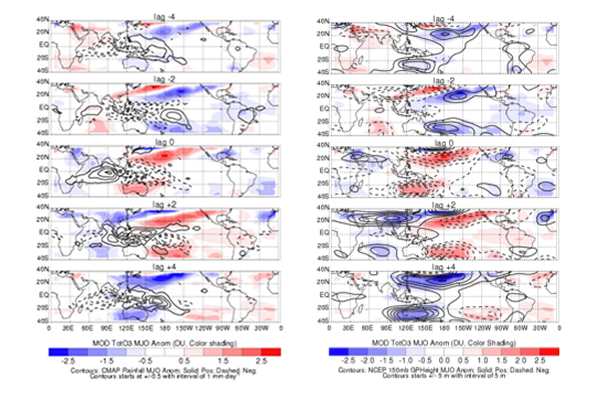The MJO and Atmospheric Composition: Total Column Ozone
by Baijun Tian
Motivation
The MJO has been shown to have important influences on various weather and climate phenomena at many time scales, such as the diurnal cycle of tropical deep convection, Asian and Australian monsoon onsets and breaks, El Niño-Southern Oscillation, tropical hurricanes, and extreme precipitation events. However, the impact of the MJO on atmospheric composition, such as ozone (O3), has yet to be well documented.
Research Summary
We investigate the intraseasonal (30–90 day) variations in satellite-observed tropical total ozone (O3) and their connection to the MJO [Tian et al., 2007]. The intraseasonal variations of the tropical total O3 are large (~±10 DU) and comparable to the total O3 variations in annual and interannual time scales associated with the annual cycle, quasi-biennial oscillation, El Niño-Southern Oscillation, and solar cycle. These total O3 anomalies are mainly evident in the subtropics over the Pacific Ocean and eastern hemisphere, with a systematic relationship to the MJO convection and dynamics. The subtropical positive (negative) O3 anomalies flank or lie to the west of equatorial suppressed (enhanced) MJO convection and propagate slowly eastward (~5 m s-1) (see left figure). The subtropical total O3 anomalies are typically anti-correlated with the subtropical geopotential height anomalies near the tropopause driven by the subtropical cyclones/anticyclones in the upper troposphere generated by equatorial MJO convection (seeright figure). This indicates that the subtropical total O3 anomalies are dynamically driven by the vertical movement of the subtropical tropopause which separates O3 rich air in the stratosphere from O3 poor air in the troposphere. Over the equatorial regions, the intraseasonal total O3 anomalies are rather small (<1 DU) and may be a result of the coupling of the O3 chemistry and dynamics.

Implications
This study has implications for the stratosphere-troposphere exchange regarding the role of tropical deep convection and its associated dynamics. Moreover, its findings may be useful to developing and assessing climate and chemistry/transport models.
Future Work
We will analyze the vertical O3 distribution in the upper troposphere and lower stratosphere using O3 data from modern satellite sensors and in-situ ozonesondes to more robustly characterize the MJO-ozone relationships and to quantify the nature and processes that contribute to both the seemingly more understandable subtropical total O3 anomalies and the weaker and/or more complex near-equatorial total O3 anomalies, particularly regarding dynamical versus chemical processes and stratospheric versus tropospheric contributions.
Reference
Tian, B. J., Y. L. Yung, D. E. Waliser, T. Tyranowski, L. Kuai, E. J. Fetzer, and F. W. Irion (2007), Intraseasonal Variations of the Tropical Total Ozone and Their Connection to the Madden-Julian Oscillation, Geophysical Research Letters, 34, L08704, doi:10.1029/2007GL029451.
